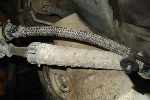gavin
Explorer Addict
- Joined
- September 27, 2002
- Messages
- 3,183
- Reaction score
- 23
- City, State
- Anchorage, Alaska
- Year, Model & Trim Level
- '97 Explorer XLT AWD 5.0L
I know I had to wiggle the arm around a lot to get the 2nd bolt out after the first was removed; since if the bolt boles aren't perfectly aligned, it won't come out.
try putting the rear bolt back in part way, then see if you can remove the front?
try putting the rear bolt back in part way, then see if you can remove the front?











